This one is a bit of a head-scratcher. On the one hand, this 1957 Harley-Davidson FLH Hydra-Glide is a very rare bike, supposedly 1 out of 167 made, according to the seller. They also say that it is a mix of three different bikes from two different decades. The seller has it listed here on eBay in Loves Park, Illinois and the current bid price is $13,200, but the reserve isn’t met.
Is this a good-looking Harley? Of course, nobody is debating that. I’d guess that even people who don’t like Harley-Davidson motorcycles (for some reason) may still like the look of this bike. Come on, it’s a vintage black Harley with studded black leather bags, fuhgeddaboudit! It has a steampunk look to it, and there’s a good reason for that, at least for Harley-Davidson scholars. The seller says that it’s a conglomeration – well, they call it an “old vintage rebuild” – of a ’38 Knucklehead frame, a ’50s Panhead, and the original ’57 tank-shift FLH. This example has a solo seat and those leather bags are great.
I don’t care if it’s half Harley and half Trabant, it’s cool as hell. Period. I mean, it’s got a four-speed eight-ball tank shifter, and Elvis bought a new one in November of 1956. It doesn’t get much cooler than that (the photo is from the ScottyMoore.net website). The FL series goes way back to just before the U.S. jumped into – or, some might say, was forced into – WWII, in 1941. The former E-series engines were now F engines, meaning Harley-Davidson’s new 74-cu.in. OHV V-twin.
There is considerable information and/or misinformation on the internet (big shocker) concerning what the letters “L” and “H” stand for in FLH. Some motorcycle sites say that the “L” signified mid-level or middling compression, which was great for American highways. Some others say it stands for a fat front tire and Hydra-Glide front forks. The letter “H” also gets bounced around. Some say that it stands for highway, and others say that it means higher compression, which means more power. I know that we have some Harley experts here who can clear that up.
The Hydra-Glide was available in 1949 and it relates to the new hydraulically-dampened front telescopic forks. The marketing wizards in Milwaukee came up with “Hydra-Glide” for the following year in 1950. You can see that this bike isn’t perfect and values are not really applicable here as it’s been modified. If it were an original ’57 FLH Hydra-Glide, Hagerty gives us a value of $13,000 in #4 fair condition and $19,800 in #3 good condition. The seller says that it’s missing the speedometer connection and dash lights.
The seller says that this engine is an early-1950s Panhead, and they would have been in the FL bikes from 1948 to 1966 when the Shovelhead took over. It’s Harley-Davidson’s 74-cu.in. (1,208-cc) two-pushrod, 45-degree V-twin, which would have had around 50 horsepower and 62 lb-ft of torque when new. It’s right there for all the world to see and enjoy, not hidden behind plastic cladding. They say that it needs some tinkering, it has a 12-volt conversion, and I would love to own this one. Big shocker. Let’s hear those Harley stories out there!
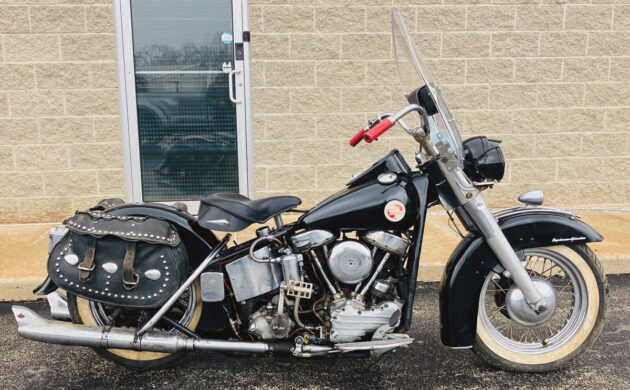
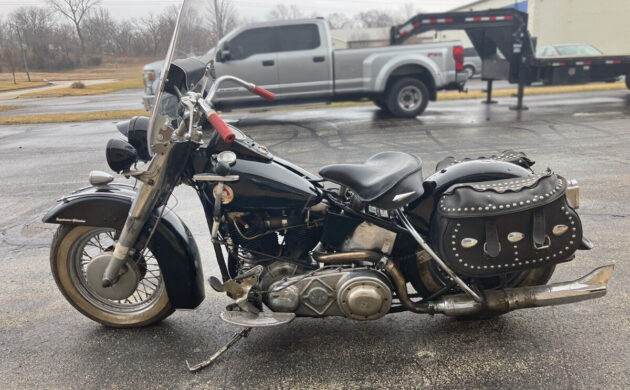
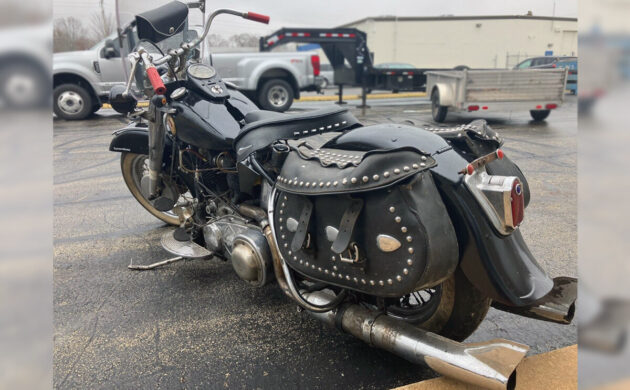

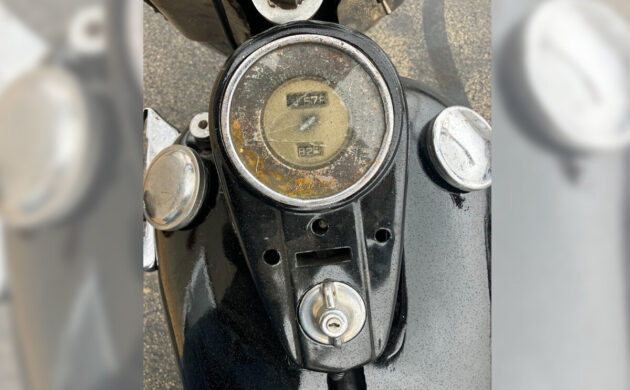
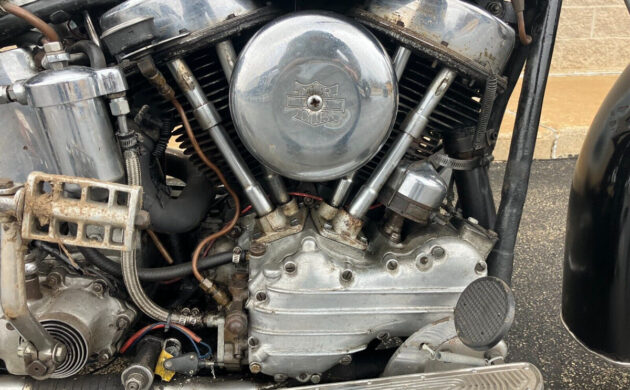


Get your motor runnin’, head out on the highway,,what a great writeup, I for once, can’t add a thing, except a big thank you. My views are certainly well known, so no need to go into that, and if you don’t like Harleys, so be it. I’ve come to realize, however, we live in a global society today, but if you lived through the “transition” period, it was a kick in the gonads. Things we held dear, like panhead Harleys, IH Scouts, Kodak cameras, no longer had the zing, and it was obvious, imported products did just as well, even better, and the rest is history.
Oh, one thing MUST be mentioned, Brooks Stevens, of Willys, Excalibur, Oscar Mayer Wienermobile, 1st clothes dryer with a window, fame, designed the Hydra-Glide. It was novel in that, before hydraulic forks, motorcycles had springer front ends, and unpredictable, at best. I think this still was a hardtail, with the seat that has a shock absorber, and I’ve heard this bike as having a “suicide shifter”, and that’s partially true, but more accurately, called, “tank shift” or “suicide clutch”. I’ve ridden a lot of bikes, but never one with a tank shift, but couldn’t be much different than the Mack trucks I drove. Yeah, put some rice grinder rider on one of these and watch the fun,,sorry, sorry, this is a great find no matter what you ride. I, like the author, like all bikes, some more than others, if it’s got 2 wheels and a motor, can’t be all bad. But for someone to say a HD is a poor bike, based on their dislike of them, for whatever reason, is a poor analogy and I sorry you have to feel that way. Not every schmoe rode a Hydra-Glide, and that’s a fact.
Oh, just one more thing( AHEM), we thought FLH stood for “Flat Landers Harley”, not a lot of hills in Wisconsin,,yer turn, folks!
This certainly IS a sight for sore eyes. Only thing more appealing than a Panhead Hard-tail is maybe a Knucklehead Hard-tail. I sure wouldn’t kick either one of them off my driveway.
A lot of people might wonder why this one has an older frame. Well, it was most likely that it was available and the original one’s back was broken. Hard-tails, no matter who built them, took a serious pounding. And they eventually broke. But I have to give them credit for being able to take it for as long as they did. These frames were STRONG, not like those flimsy, anemic chopper frames that someone scabbed together out of pipe cleaners and electrical conduit. I’ve seen chopper frames give out in less than a year.
FLH? OK, let me take a stab at it. I think that we can all agree that “F” represents “Big Twin-OHV.” Scotty has it right with “L” meaning higher compression. The “H” meaning “Highway” is as good as anything else but I don’t think it has anything to do with the traditional “Cat Squasher” front tires as the 45s had those same tires. I remember other 3rd letter designations on other bikes. I was told that the “A” in WLA stood for Army or Military, and the “C” in WLC stood for ‘Civilian.’ Then some trackstar told me that the ‘C’ stood for “Canadian Military.” Well, the Canadians used H-Ds in the military too but the ones I saw on display in museums were WL(A), just like the US. Some say the H stands for Hydra-Glide but it seems to me that the H came out before hydraulic front forks (As in UH and ULH).
“Hydra-Drive?” I never heard that term until today. I always thought they were “Hydra-Glide.” But then, there’s a lot of stuff I still have to learn, even at 3Score+10…
Let’s see, from my US history days, a score is 20, so you got me beat by 2 years. I read, foot shift became an option in 1952, and unusual this would still have a tank shift. Just shows, the mindset of the riders back then. What many today don’t realize, is outside of a city, most roads were still gravel, and riding a bike on gravel roads took some skill. Hydraulic forks eliminated “pogo sticking” a springer would do, and a marked improvement. The Duo-Glide came out the next year, 1958, with rear shocks, and pretty much stayed that way. A local mechanic got his dads AMF FLH after he died, and wouldn’t sell it for the world, I asked.
And if I may throw my two cents in, the Electra-Glide meant electric start!
Hi Howard. One thing I have learned in my 66 years of motorcycling is that after owning 53 motorcycles so far, 6 or 7 being Harley’s, the rest were mostly British with some German and Italian bikes thrown in, I must say that although I don’t go for Harley’s I have to admit that the first time I ever rode a Harley it was a 750cc WLA I think, 1941 model, one of more than 5000 ordered by the South African Army during WW2, and it was on a gravel road. I couldn’t believe how easy it was to ride in comparison to all of the other makes of bike. I seem to remember it having 600/16″ car tyres. I even road it “no hands” for about 100 yards or so without worrying whether or not I would end up looking a bit stupid. This pic is of the same bike as I later bought it from the “lady” that loaned it to me for the first practice ride.
Geo, thanks for catching that typo!
American Pickers
Just to add my 2 cents, this ia a tank shift with a rocker clutch. A suicide clutch is like a car clutch where you have to keep your foot on ti when stopped in gear, With a rocker clutch you can disengage and it will stay that way until you put it in the forward position. I don’t think any Harley came from the factory with a suicide clutch. I think the tank shift was available up until 1974 as many police depts. requested it. This bike like a lot of old Harleys was put together with different parts. There was no serial # on the frame, just the motor. If this motor is from the early ’50s was the vin.# restamped?
When the de tent on the pedal wore out it became a suicide clutch.
Never take your left foot off the pedal.
VIN looks fine. Tanks and dash are a mess.
I read recently that HD is heading for an all-electric model line.
They already make the LiveWire, which is all-electric.
That will be the kiss of death if everything they sell is electric.
They’ll keep selling gas-powered bikes too. The Live Wire has been a terrible seller.
I don’t think it’s a Knuckle head frame. I have ’49 Pan in a Knucklehead frame and two major visual things – Knuckle frames are ‘straight legged’ and Pan frames are ‘dog legged’, referring to the downtubes from the neck to the front motor mount. You can see in one of the pictures a very poor repair/splice where I think someone modified the downtube to be straight. Knuckehead frames were considered a lot ‘cooler’ in the chopper years (’60s). The other reason I think it’s a modified Pan frame is the clearance over the rear panhead – in order to get a panhead motor into a knucklehead frame you have to beat the top frame tubes up to clear the pan (mine has just enough to slide a business card between the frame and the top of the dishpan) and the seatpost tube had to be flattened to the rear also to clear the panhead, which meant you could not run a stock suspended seat. I know from years of sitting on a padded seat directly on the frame ala ‘chopper’. So I think this is/was someone’s personal ‘pride & joy’, but I don’t think it’s something rare from the factory. Do your own due diligence before parting with your cash.
It looks like the neck was modified.
Someone must have taken the chopper rake out of the frame and smoothed it with bondo
L54 to 57 were stright leg frames not wishbone.
Dave, you’re exactly right on beating the seat post tube in to clear the rear pan. If true, there wouldn’t be room for the (seat) pogo stick. So, almost certainly not a knuckle frame.
WLA meant (US) Army. WLC meant Canadian army. On the ‘suicide’ clutch issue, geezerglide85 is correct in describing the ‘rocker’ clutch which is SO often mis-described. We did have a ’73 Police Servi-car (45″ 3-wheeler) that was stock, stock original with a ‘suicide clutch pedal.’ A rocker would have been nice but the car-type pedal was fine since it was more like driving a car anyway.
Love the look. As geezer mentioned (and Scotty) … it’s a hodge-podge of parts from other bikes – a ‘rat bike’ was the term used when I rode. I had a ’78 FLH that was a complete rat from the Kentucky blue-plate frame on up. My mechanic was convinced it had originally been stolen and then the original numbers removed and parts from other bikes thrown … and then registered in Kentucky where the laws were looser for the time. It’s not always right, but a quick tell for rat bikes is the gap shown between the seat and the speedo. That was often there when you put parts from other bikes together as you would need to make a new cover with the custom length and width. Mine had that gap and I simply used leather over it. All that said, this one has a great look. Many rats didn’t look right and had more of a Frankenstein feel to them.
My 74 shovelhead FLH had a weird plate over the spot on the casings where the vin should be. When I bought it, I asked the guy about it and he said, “it’s got a title.” But in 91 I paid a very minor sum for it. I’m sure it was a mutt, but I had a good time riding it. When I started commuting 50 miles each way, I needed something more reliable and bought a new Road King. Infinitely better bike, but with half the soul.
Ask Vinnie Terranova from the closed up Rocky Mountain Harley Davidson, he’d be able to tell ina heartbeat…
cool looking bike but it is made from many bikes. any other bike made from many bikes even if cool would be worth a lot less. i see $7000 tops just for some of the rarer parts used. need to put in 5000 just to get it looking like it should. so who would pay 13000 for this running parts bike?
FL was the designation for a 74 cu. in. engine. EL was for a 61 cu.in. engine. The H was for Hot or High compression. Harley used a rigid frame until 58 when they introduced a rear suspension. They became known as “Duo-Glides” then.
1949 HD goes from springer front end to hydraulic front end = Hydra Glide; Adding rear hydraulic suspension 1952 K model and 1958 EL & FL models = Duo Glide
You’re correct…
My factory Duo-Glide and Electra-Glide manuals state as such.
FL = Big Twin
(FL designation applies to this day on all Big Twin models ie, FLHST, FLHR etc)
H = High Compression
EL 60 CI Hydra-Glides were discontinued in 1952 due to low sales.
The FLH models had a taller sprocket ratio than the FL as well.
The FL models were preferred by fleet applications such as police departments and some military applications for lower speed uses.
This particular bike appears to be a bit of a ‘bitsa’ bike and most HD’s from 1978 back tend to be bitsa this and bitsa that.
It’s a very nice bike (the whitewalls suck) though.
I own a ‘56 Hydra-Glide much as Elvis owned and also a ‘71 Electra-Glide which is exactly like the one Elvis is sitting on (in high heel boots) with a hot babe in Memphis. It’s usually the most common photo that’ll pop up when Elvis and Harley are Googled simultaneously.
I also own a 1960 Duo-Glide and not sure if Elvis owned one of those but he bought and gave away a LOT of Harley’s and some Caddies and Lincoln’s too.
The rarity claim on this bike seems to be a stretch and if anything the FL might have been sold in lower numbers that year due to fleet only sales and the Eisenhower recession in ‘57.
It seems that you’ve got the ‘H’ nailed down the best here. I was always somewhat vague on it even though I put a lot of miles on a Shovelhead and a 45. I had a couple of acquaintances who rode big twin flatheads that went under the UL and ULH moniker. The UL was a 74 while the ULH was an 80. That confused me as to the H because it looked like the H stood for bigger twin but I was probably wrong. My Shovelhead was an FLH 80; while my cousin rode an FLH 74. I remember seeing the difference between the two almost immediately as the 74 cylinders had 10 fins while the 80 had 9. I’ll never know the reason for that.
Determining prices on pre 1978 Harleys can be a tough nut to crack.
They’re most often bitsa bikes and only 100% stock bikes will bring “Good” to “Excellent” Hagerty prices…
I’ve been getting eBay Big Twin bikes in my Search emails for about twenty years now and I buy and sell at least 2-3 Big Twins (Usually Shovelheads) per year and this bike is most likely in the $15K – $18K range based on going prices…
Davenport prices excluded.
The H is definitely for high compression , my first Panhead was a ’55 FLH , the first year for FLH , had Panheads since ’86 , most of the time with suicide clutch & jockey shift , my favourite HD for sure
I remember a specification listing of models for the final year of panheads, known as the Duo-Glide.
FLFB, FLFHB, FLHF, FLHFB. The difference between the models related to compression ratios (“sports” models.) and coil or magneto ignition systems. The first Harley that Presley went out and bought and which he is photographed on was a flathead model K Sportster 45 c.i. which was seen as an alternative to English bikes like the Triumph Tiger 110.
The H has stood for many things over the years.
In the early 10’s and 20’s, the H stood for ‘race’..such as CAH engines.
In the 30’s the H was put on the bigest variant of a type: JD, VL, UL were all 1200’s (74 ci), while the H (JDH, VLH and ULH) were 1340’s (80ci).
After the waryears, the H even stood for Holland in the WLH 45s, just as the C in WLC stood for Canada.
In more modern years, the H stood and stands for Hot..
first off they say it’s a Knucklehead frame, well a panhead motor willnot fit in a knuckle frame without modifctions to the frame,